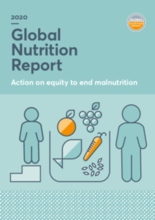Executive Summary
The Global Nutrition Report calls on governments, businesses and civil society to step up efforts to address malnutrition in all its forms and tackle injustices in food and health systems.
Everyone deserves access to healthy, affordable food and quality nutrition care. This access is hindered by deeper inequities that arise from unjust systems and processes that structure everyday living conditions. This year’s Global Nutrition Report uses the concept of nutrition equity to elucidate these inequities and show how they determine opportunities and barriers to attaining healthy diets and lives, leading to unequal nutrition outcomes. We examine the global burden of malnutrition with an equity lens to develop a fuller understanding of nutrition inequalities. In doing this, we pinpoint and prioritise key actions to amplify our efforts and propel progress towards ending malnutrition in all its forms.
The Global Nutrition Report calls for a pro-equity agenda that mainstreams nutrition into food systems and health systems, supported by strong financing and accountability. With only five years left to meet the 2025 global nutrition targets, time is running out. We must focus action where the need is greatest for maximum impact.
The report notes that global Infant and young child feeding (IYCF) practices remain poor an examines inequalities within IYCF, including by by urban–rural location, sex, wealth and education. The report also explores the prevalence of stunting, wasting and overweight (including obesity) in children aged under 5 years by urban–rural location, sex, wealth and education. The report finds significant inequalities by wealth in solid food introduction, meal frequency, dietary diversity and minimum acceptable diet, as well as stunting and wasting, noting that children from the richest households do far better in these areas.
"Such wealth, location and education gaps are evident even in mostly low- and lower-middleincome settings. This perpetuates vulnerability and creates barriers to escaping poverty, posing a significant challenge to the global community and its commitment to leave no one behind and reach the zero-hunger target."

